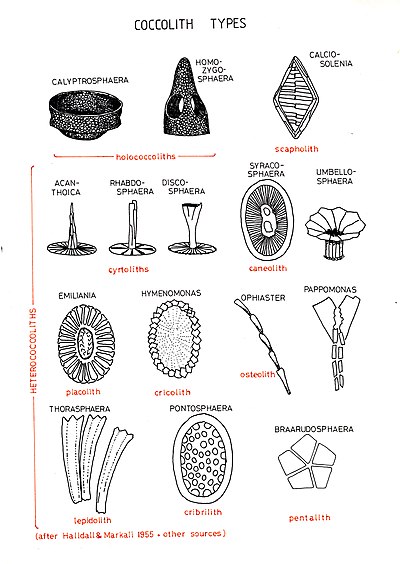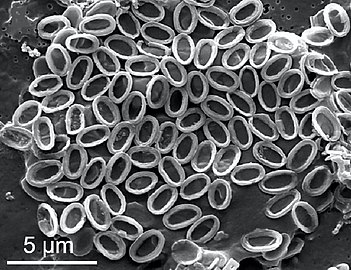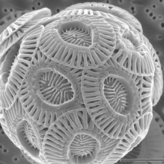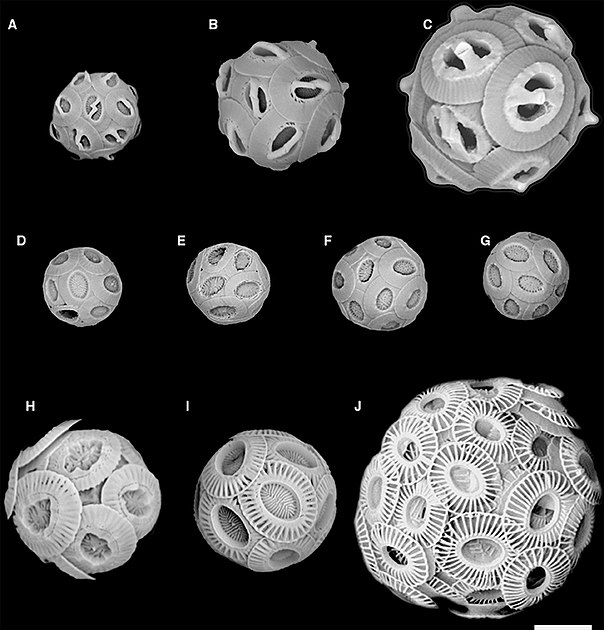Coccolith
Coccoliths are individual plates or scales of
Overview
Coccolithophores are spherical cells about 5–100 micrometres across, enclosed by calcareous plates called
-
Partial cross section of a coccolithophore with coccolith layer [4]
-
Coccolithophore cell surrounded by its shield of coccoliths. The coccolith-bearing cell is called the coccosphere.[5][6]
Coccolithophores have been an integral part of
As of 2021, it is not known why coccolithophores calcify and how their ability to produce coccoliths is associated with their ecological success.
Formation and composition
| Part of a series related to |
| Biomineralization |
|---|
 |
Coccoliths are formed within the cell in
-
Collapsed coccosphere of Pleurochrysis carterae
Types
There are two main types of coccoliths, heterococcoliths and holococcoliths. Heterococcoliths are formed of a radial array of elaborately shaped crystal units. Holococcoliths are formed of minute (~0.1 micrometre) calcite

Shape
Coccoliths are also classified depending on shape. Common shapes include:[34][35]
- Calyptrolith – basket-shaped with openings near the base
- Caneolith – disc- or bowl-shaped
- Ceratolith – horseshoe or wishbone shaped
- Cribrilith – disc-shaped, with numerous perforations in the central area
- Cyrtolith – convex disc shaped, may with a projecting central process
- Discolith – ellipsoidal with a raised rim, in some cases the high rim forms a vase or cup-like structure
- Helicolith – a placolith with a spiral margin
- Lopadolith – basket or cup-shaped with a high rim, opening distally
- Pentalith – pentagonal shape composed of five four-sided crystals
- Placolith – rim composed of two plates stacked on top of one another
- Prismatolith – polygonal, may have perforations
- Rhabdolith – a single plate with a club-shaped central process
- Scapholith – rhombohedral, with parallel lines in center
-
Coccolith structures of representativemorphospeciesis associated with a SEM image in the next diagram
-
SEM images correspond to coccolith drawings in the previous diagram
(A) Gephyrocapsa ericsonii RCC4032 (B) Gephyrocapsa muellerae (C) Gephyrocapsa oceanica (D) Reticulofenestra parvular RCC4033; (E) Reticulofenestra parvular RCC4034; (F) Reticulofenestra parvular RCC4035; (G) Reticulofenestra parvular RCC4036; (H) Emiliania huxleyi morphotype R; (I) Emiliania huxleyi morphotype A; (J) Emiliania huxleyi morphotype B.
Function
Although coccoliths are remarkably elaborate structures whose formation is a complex product of cellular processes, their function is unclear. Hypotheses include defence against grazing by
Fossil record
Because coccoliths are formed of low-Mg calcite, the most stable form of calcium carbonate, they are readily fossilised. They are found in sediments together with similar microfossils of uncertain affinities (nanoliths) from the
References
- .
- ^ ISSN 2296-7745..
 Material was copied from this source, which is available under a Creative Commons Attribution 4.0 International License
Material was copied from this source, which is available under a Creative Commons Attribution 4.0 International License - ISSN 1932-6203..
 Modified material was copied from this source, which is available under a Creative Commons Attribution 4.0 International License
Modified material was copied from this source, which is available under a Creative Commons Attribution 4.0 International License - S2CID 6227548.
- ISSN 0377-8398.
- ISBN 978-3-642-06016-8.
- ISBN 978-3-642-06016-8.
- .
- .
- S2CID 34159028.
- .
- hdl:2268/246251.
- ISBN 978-3-642-06016-8.
- ^ Young, J. R. (1987). Possible Functional Interpretations of Coccolith Morphology. New York: Springer-Verlag, 305–313.
- ^ Young, J. R. (1994). "Functions of coccoliths," in Coccolithophores, eds A. Winter and W. G. Siesser (Cambridge: Cambridge University Press), 63–82.
- hdl:10453/114799.
- ^ PMID 27453937.
- .
- ISBN 9780123705181.
- S2CID 21017882.
- PMID 30043404.
- .
- S2CID 22995996.
- S2CID 135347218.
- ^ Young, J. R. (1994) "Functions of coccoliths". In: Coccolithophores, Eds A. Winter and W. G. Siesser (Cambridge: Cambridge University Press), 63–82.
- S2CID 36526359.
- .
- ^ Huxley, Thomas Henry (1858). "Appendix A". Deep Sea Soundings in the North Atlantic Ocean between Ireland and Newfoundland, made in H.M.S. Cyclops, Lieut.-Commander Joseph Dayman, in June and July 1857. London: British Admiralty. pp. 63–68 [64].
- ^ Huxley, Thomas Henry (1868). "On some organisms living at great depth in the North Atlantic Ocean". Quarterly Journal of Microscopical Science. New series. 8: 203–212.
- .
- ISSN 1886-8134.
- ISBN 978-960-411-660-7.
- ISBN 978-0-521-03169-1.
- ISBN 978-0-323-13827-7.
- ISSN 1664-302X..
 Modified material was copied from this source, which is available under a Creative Commons Attribution 4.0 International License
Modified material was copied from this source, which is available under a Creative Commons Attribution 4.0 International License
External links
- The EHUX website - site dedicated to Emiliania huxleyi, containing essays on blooms, coccolith function, etc.
- International Nannoplankton Association site - includes an illustrated guide to coccolith terminology and several image galleries.
- Nannotax - illustrated guide to the taxonomy of coccolithophores and other nannofossils.
- Cocco Express - Coccolithophorids Expressed Sequence Tags (EST) & Microarray Database
- Possible functions of Coccoliths

![Partial cross section of a coccolithophore with coccolith layer [4]](http://upload.wikimedia.org/wikipedia/commons/thumb/b/b3/Cross_section_of_a_coccolithophore_with_coccolith_layer.png/355px-Cross_section_of_a_coccolithophore_with_coccolith_layer.png)
![Coccolithophore cell surrounded by its shield of coccoliths. The coccolith-bearing cell is called the coccosphere.[5][6]](http://upload.wikimedia.org/wikipedia/commons/thumb/2/23/Diagram_of_a_coccolithophore_cell_and_its_shield_of_coccoliths.png/484px-Diagram_of_a_coccolithophore_cell_and_its_shield_of_coccoliths.png)




![Coccolith structures of representative Noelaerhabdaceae.[36] Each morphospecies is associated with a SEM image in the next diagram](http://upload.wikimedia.org/wikipedia/commons/2/28/Coccolith_structures_of_representative_Noelaerhabdaceae.jpg)
